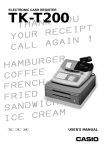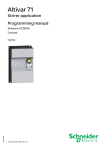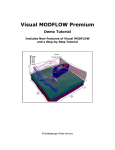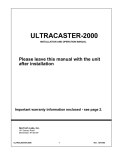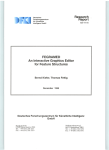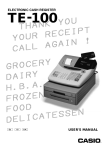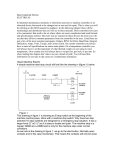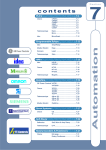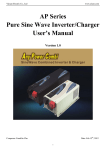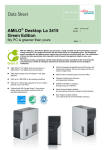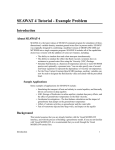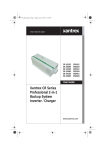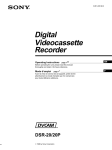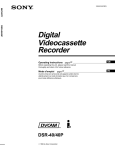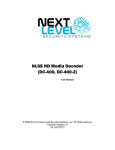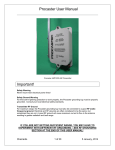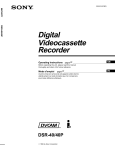Download RessqM, Enhanced Version of RESSQ [Javandel et al., 1984]
Transcript
RessqM for Windows User's Manual 1 RessqM Version 2.0 for Windows User's Manual DISCLAIMER WellWare and Gerald T. O'Neill make no representations or warranties with respect to the contents hereof and specifically disclaim any implied warranties of fitness for any particular purpose. WellWare and Gerald T. O’Neill will not be liable for any damages, losses, or claims consequent to use of this software or the methods described herein. Further, WellWare and Gerald T. O'Neill reserve the right to revise this publication and software, and to make changes from time to time in the content hereof without obligation to notify any person of such revisions or changes. Models are useful tools and it is the responsibility of the user of a model to correctly apply it in a meaningful way. Copyright © 1990–1993 by Gerald T. O'Neill. All Rights Reserved. No part of this manual may be reproduced or transmitted in any form or by any means, electronic or mechanical, including photocopying, scanning, and recording, for any purpose other than the purchaser's personal use, without the written permission of WellWare and Gerald T. O'Neill. The software programs on the accompanying disk may not be copied, except to install on one computer "hard disk" and for backup purposes only by the original purchaser. WellWare ™ 3717 Modoc PL Davis, CA 95616 (916) 758-0290 Effective Software for Groundwater Professionals RessqM for Windows User's Manual 2 RessqM Version 2.0 for Windows User's Manual Contents DISCLAIMER...................................................................................................................................................1 RessqM Requirements ......................................................................................................................................3 Software Installation .........................................................................................................................................3 SURFER .............................................................................................................................................3 RessqM Installation............................................................................................................................4 Diskette Files .....................................................................................................................................................5 Quick Start .........................................................................................................................................................6 Introduction .......................................................................................................................................................7 RESSQ ................................................................................................................................................7 Why RessqM? ....................................................................................................................................7 RessqM Applications .........................................................................................................................8 Data Input ..........................................................................................................................................................10 PRERQM ............................................................................................................................................10 Defaults ................................................................................................................................13 Calculated Variables ...........................................................................................................13 RessqM ...............................................................................................................................................14 Using Existing RESSQ Data Sets .....................................................................................................14 Data Input Summary ..........................................................................................................................15 Running RessqM ...............................................................................................................................................16 RessqM Output..................................................................................................................................................18 Graphics .............................................................................................................................................................18 File Notes...........................................................................................................................................................19 Utility Programs ................................................................................................................................................19 ZQWELL ............................................................................................................................................19 MKGRD..............................................................................................................................................19 UNITS.................................................................................................................................................20 STRIP..................................................................................................................................................20 Examples............................................................................................................................................................21 Example 1, Capture Zone of a Single Pumping Well ......................................................................21 Example 2, 1 Pumping Well and 1 Recharge Well..........................................................................23 References..........................................................................................................................................................26 Acknowledgments.............................................................................................................................................26 FIGURES APPENDIX —Modeling Approaches for Hydraulic Control of Groundwater Contamination WellWare ™ 3717 Modoc PL Davis, CA 95616 (916) 758-0290 Effective Software for Groundwater Professionals RessqM for Windows User's Manual 3 RessqM Requirements • IBM-PC 386 SX or higher or 100% compatible microcomputer with hard disk drive, MS-DOS® 5.0 or higher and Windows Version 3.1 or higher. Windows must be run in 386 Enhanced Mode. • Golden Software, Inc. SURFER® version 4 or higher and SURFER compatible graphics adapter, monitor, and printer or plotter. • A math coprocessor is used if present; however, it is not required. Software Installation SURFER SURFER® is required for RessqM graphics on a PC. It is not included with RessqM and can be purchased from Golden Software, Inc. by calling 1-800-333-1021 or 1-303-2791021. SURFER should be installed before using RessqM and must be available to RessqM through the DOS PATH command. The following shows one way of correctly configuring SURFER for use with RessqM. • Install SURFER in a directory called C:\SURFER. • Add SURFER to the PATH command in the AUTOEXEC.BAT file as follows: PATH C:\;C:\DOS;C:\SURFER; etc. • Restart the computer. • At the DOS prompt, configure SURFER for your video hardware and output device by typing the following commands: PLOT/i Enter This command will configure SURFER for use with your output device (printer, plotter, graphics file format). VIEW/i Enter This command will configure SURFER for use with your video display hardware. WellWare ™ 3717 Modoc PL Davis, CA 95616 (916) 758-0290 Effective Software for Groundwater Professionals RessqM for Windows User's Manual 4 RessqM Installation 1. Start Microsoft Windows. 2. Insert the RessqM diskette into the appropriate drive A or B. 3. Select Run from the Program Manager File menu and type A:INSTALL or B:INSTALL and then press Enter or choose the OK button. 4. INSTALL will copy RessqM files to your C: drive into a directory named C:\RESSQMW. 5. -a- Create a new group for RessqM in Program Manager; From the File menu, choose New. The New Program Object dialog box appears. -b- Select the Program Group option, and then choose the OK button. The Program Group Properties dialog box appears. -c- In the Description box, type RessqM. In the Group File box, type C:\RESSQMW\RESSQM and then choose the OK button. The RessqM Group appears (the following view is maximized): 6. Installation is now complete! We suggest that you review this User's Manual and the Example Problems before using RessqM. WellWare ™ 3717 Modoc PL Davis, CA 95616 (916) 758-0290 Effective Software for Groundwater Professionals RessqM for Windows User's Manual 5 Diskette Files The following files are found on the accompanying diskette: INSTALL.BAT A batch file for installing RessqM on a hard disk. GRAPH.BAT A batch file for running SURFER to create graphics. RESSQM.IL RessqM icon library. RESSQM.GRP RessqM Program Manager group file. RESSQM.CMD A TOPO command file for creating RessqM Graphics. RESSQM.PST A TOPO posting file for displaying front positions. EXAMPLE#.DAT RessqM example data set. EXAMPLE#.TXT Corresponding RessqM output file for Example#. EX2ZQW.DAT RessqM Example 2 data set with ZQWELLs included. EX2ZQW.TXT RessqM output file corresponding to EX2ZQW.DAT. RESSQMW.EXE RessqM for Windows program. PRERQMW.EXE Data preprocessor for RessqM for Windows. ZQWELLW.EXE ZQWELL for Windows program. ZQWELL.DAT Example ZQWELL data set. ZQWELL.OUT Example ZQWELL output. MKGRDW.EXE Utility program for creating a TOPO.GRD file. STRIPW.EXE Utility for expressing carriage control formats. UNITS.EXE Units conversion program by HydroLink. WellWare ™ 3717 Modoc PL Davis, CA 95616 (916) 758-0290 Effective Software for Groundwater Professionals RessqM for Windows User's Manual 6 Quick Start If you do not wish to read the manual at this time, and have already installed SURFER and RessqM (see Software Installation), simply start Windows and then double-click on the RessqM Program Group Icon in Program Manager to open the RessqM Group. Then, simply double-click on the icon corresponding to the task you wish to perform: Double-click Icon: Description: PRERQM Create RessqM data files. RESSQM Run RessqM. UNITS Make Units conversions. Graph Create RessqM graphics. MKGRD Create a TOPO.GRD file from a RESSQ file. ZQWELL Create a data set for plotting regional flow lines. STRIP Prepare RESSQM.TXT for printing. Notepad Create, Edit, and Print RessqM data files. WellWare ™ 3717 Modoc PL Davis, CA 95616 (916) 758-0290 Effective Software for Groundwater Professionals RessqM for Windows User's Manual 7 Introduction RessqM (Ressq Modified) is an enhanced version of the popular RESSQ model [Javandel et al., 1984]. RessqM was developed to facilitate the rapid analysis of capture zone and well head protection problems. RessqM makes it easy to determine the extent of capture zones of wells in steady uniform groundwater flowsat user specified times. A preprocessor, PRERQM, is provided to help users quickly and easily create RessqM data files and custom graphics with Golden Software's SURFER. In addition, SURFER graphics files are provided that automatically plot streamline patterns and front positions determined by RessqM. RessqM is a significant improvement over RESSQ in terms of ease of use, speed in setting up and solving problems, and plotting graphics. RESSQ RESSQ is a computer program for two-dimensional contaminant transport by advection and adsorption in a homogeneous, isotropic confined aquifer of uniform thickness where regional flow, sources, and sinks create a steady-state flow field. RESSQ is a semianalytical model, employing both analytic and numerical solution schemes. The complex velocity potential of the system is determined analytically, and numerical particle tracking is used to trace streamlines and determine contaminant front positions of injection wellsor, equivalently, capture zones of pumping wellsat user specified times in uniform, steady state flows. RESSQ is described in detail in the handbook by Javandel et al. [1984]; it is assumed that users have access to this book and are familiar with RESSQ. Therefore, details of the RESSQ program will not be reiterated here. Ordering information for the handbook is provided under Acknowledgments. The purpose of this manual is to document RessqM and its use of Golden Software's SURFER to create graphics. Example problems are presented in some detail, including problems described in Javandel et al. [1984]. Why RessqM? RESSQ has long been described as being user hostile! RESSQ had minimal graphics support and was not practically useful. These limitations have been addressed by RessqM. In addition, RessqM generates SURFER files that allow for custom graphics drawn to scale. Automatic compatibility with numerous graphics output devices is WellWare ™ 3717 Modoc PL Davis, CA 95616 (916) 758-0290 Effective Software for Groundwater Professionals RessqM for Windows User's Manual 8 supported by SURFER's PLOT routine1. It is assumed that RessqM users have purchased SURFER from Golden Software, Inc. and are familiar with its use. There are other software solutions to the problem of drawing streamlines. For steady state uniform groundwater flows, AqModel by WellWare [O'Neill, 1992] calculates streamlines as well as drawdown and equipotentials. However, AqModel does not directly facilitate determining the extent of groundwater movement to or from a well at a specified time. This is where RessqM excels. But RessqM does not facilitate plotting of drawdown or equipotentials as AqModel does; therefore, it is practical to have models for each type of problem, and AqModel and RessqM compliment each other very well. Other powerful modeling approaches for more complicated problems include using a numerical flow model (e.g., MODFLOW) and a particle tracking code (e.g., PATH3D). See O'Neill [1990] in the Appendix for more information. Together with PRERQM, RessqM provides easy access to the powerful features of RESSQ. And with its automatic interface to SURFER, RessqM is a practical problem solving tool. RessqM Applications Since RessqM is essentially an enhanced version of RESSQ with powerful graphics support, it can be used in exactly the same way as RESSQ. RessqM User’s Manual gives examples of using RessqM to (1) analyze the capture zone of a single pumping well and (2) determine the flow pattern and contaminant distribution around a recharge and pumping well. The handbook by Javandel et al. [1984] additionally describes the use of RESSQ for analysis of a variety of problems; it is highly recommended that users become familiar with this book and its example problems. RESSQ draws the flow pattern by tracing streamlines from injection wells [Javandel et al., 1984]. Since streamlines define groundwater pathlines in steady state flows [see the Appendix], RESSQ shows the paths that groundwater follows as it leaves an injection well in uniform flow. RESSQ also determines “contaminant” front positions along streamlines at user specified times. In addition, RESSQ calculates the time of arrival of a streamline leaving an injection well and arriving at a production well—and the evolution of concentration at a production well. All these RESSQ features are available in RessqM and are demonstrated with the two example problems presented in this manual. Because RESSQ calculates streamlines only from injection wells, we must make use of symmetry to apply RessqM to pumping wells. For a given problem, the outline of a 1SURFER supports a wide variety of graphics cards, monitors, printers (including PostScript®) and plotters—and graphics formats including AutoCAD DXF and HPGL. Used in conjunction with SURFER, RessqM is a powerful analytical and presentation tool. WellWare ™ 3717 Modoc PL Davis, CA 95616 (916) 758-0290 Effective Software for Groundwater Professionals RessqM for Windows User's Manual 9 contaminant front from an injection well at a time t is identical to the capture zone of a pumping well at the same location and with the same flow rate if the direction of regional groundwater flow is reversed (add 180° to flow direction)2. So in order to determine the capture zone of a single pumping well using RessqM, we must input it as an injection well and add 180° to the flow direction. It was decided to keep this convention in RessqM to maintain compatibility with RESSQ's data format. This convention applies to problems where we want to know the capture zone of a pumping well (see Example 1). In the case of multiple wells, to outline the region from which contaminant is produced, input all sinks as sources and vice versa, add 180° to the flow direction and request that the front location be calculated at time t [Javandel et al., 1984]. The utility program ZQWELL [Javandel et al., 1984] provided with RessqM is used to show regional groundwater flow streamlines. RessqM will calculate one streamline from an injection well if the flow rate is zero. ZQWELL determines the number and locations of zeroflow rate injection wells needed to delineate the regional flow in the vicinity of the injection and production wells being analyzed in the problem. The use of ZQWELL with RessqM will be illustrated in Example 2. 2See Note 6. in Javandel et al. [1984] pp. 177-178. WellWare ™ 3717 Modoc PL Davis, CA 95616 (916) 758-0290 Effective Software for Groundwater Professionals RessqM for Windows User's Manual 10 Data Input Data input is accomplished by using PRERQM to create a RessqM data file. PRERQM is a preprocessor that uses common English measures and handles necessary units conversions. PRERQM defaults for RessqM variables enable the rapid setup of capture zone problems (see Defaults and Calculated Variables). And, PRERQM creates the grid file needed by SURFER to generate a map. PRERQM data must be input in the units specified because units are converted in the program. A handy program called UNITS is provided (compliments of Milovan S. Beljin of HydroLink) for units conversions. Simply double-click on the UNITS icon to run UNITS. The program is user friendly and self explanatory. There are two data file formats that you must be aware of (1) PRERQM and (2) RessqM format. These are described below. TIP Don't be too concerned with the different file formats for now. PRERQM and RessqM will automatically manage the required files in most situations. First go through the example problems and refer to this section later as needed. PRERQM PRERQM data input is by free-formatted3 data file or interactive screen entry. To run PRERQM double-click on its icon. Enter data by typing responses to PRERQM prompts and then by pressing the Enter key. The following figure shows part of the interactive PRERQM screen display with data from EXAMPLE1.DAT. On-Line Help is available for the PRERQM Windows interface. Select Index from the Help menu for a hypertext list of menu commands and procedures for which help is available. 3See Table 1 for a description of PRERQM data file format. WellWare ™ 3717 Modoc PL Davis, CA 95616 (916) 758-0290 Effective Software for Groundwater Professionals RessqM for Windows User's Manual 11 If interactive screen data input (Enter Data From 2 = Screen) is then selected (see Figure 1), the input data will be saved in the user specified RessqM formatted data file (EXAMPLE1.DAT) and in a free-formatted PRERQM data file called "PRERQM.DAT" (see Figure 2). Later, if edits are required, you will find it is much easier to edit the PRERQM.DAT file than the file in RessqM format (see Figure 3). In light of this, and because PRERQM.DAT is overwritten each time Enter Data From 2 = Screen is selected, you may want to save a copy of, or rename, PRERQM.DAT to another file name immediately after running PRERQM. For example, use the Windows File Manager to rename PRERQM.DAT to FILENAME.DAT. Then, for subsequent model runs based on the same data set, edit "FILENAME.DAT" using the Windows Notepad, and run PRERQM againthis time selecting Enter Data From 1 = File (see Figure 1) and enter the file name. In this way, it is easy to create a data file for RessqM by first creating or editing a data set in PRERQM format, and then running PRERQM to convert the data set to RessqM format (Enter Data From 1 = File). PRERQM data file format is listed in Table 1. WellWare ™ 3717 Modoc PL Davis, CA 95616 (916) 758-0290 Effective Software for Groundwater Professionals RessqM for Windows User's Manual 12 TABLE 1. PRERQM DATA FORMAT LINE 1 TITLE - TITLE OF SIMULATION (up to 80 characters) LINE 2 NWI - NUMBER OF INJECTION WELLS LINE 3 NWP - NUMBER OF PUMPING WELLS LINE 4 HEIGHT - THICKNESS OF THE AQUIFER (ft) LINE 5 K - HYDRAULIC CONDUCTIVITY (ft/day) LINE 6 GRAD - HYDRAULIC GRADIENT OF REGIONAL FLOW LINE 7 POR - POROSITY LINE 8 ALPHA - FLOW DIRECTION4 (in degrees) LINE 9 + NAMEW - WELL IDENTIFIER5 (in 'single quotes') XW - X-COORDINATE OF WELL (ft) YW - Y-COORDINATE OF WELL (ft) QW - FLOW RATE AT WELL (gpm) LINE 10 CI - STREAMLINE CONTOUR INTERVAL6 (gpm) LINE 11 NFRNTS - NO. OF FRONTS (maximum = 7) LINE 12 + DATE(S) - TIMES TO CALCULATE FRONTS7 (years) LINE 13 TMAX - MAXIMUM TIME OF SIMULATION (years) LINE 14 DL - STEP LENGTH8 (ft) LINE 15 LIMITS - XMIN, XMAX, YMIN, YMAX9 (ft) 90 4Direction of uniform regional groundwater flow, in degrees, measured counterclockwise from the positive (+) X-axis being 0 degrees to a vector in the direction of groundwater flow. If ALPHA is negative, PRERQM will add 360 to the number. Therefore, to specify flow in a clockwise direction from 0 degrees as shown above, a negative number may be used (e.g., –20 = 340). 180 135.00° 0 (360 270 5Enter NAMEW, XW, YW, QW delimited by a space, comma, or tab on the same line. List all injection wells first (including ZQWELLs), followed by the pumping wells. LINE 9 + means: LINE 9 through the total number of wells (NWI + NWP). One line is required for each well. 6The contour interval is used to determine the number of streamlines for each injection well such that the magnitude of flow between adjacent streamlines is constant and equals the contour interval. 7Up to 7 values of time may be input on LINE 12 and subsequent lines, the number of which is determined by the value of NFRNTS. 8If DL is input as a number less than or equal to zero, DL is forced to be equal to (XMAX-XMIN)/200. 9Enter the limits of the model calculation area delimited by a space, comma, or tab on the same line. WellWare ™ 3717 Modoc PL Davis, CA 95616 (916) 758-0290 Effective Software for Groundwater Professionals RessqM for Windows User's Manual 13 Defaults PRERQM assigns defaults to some RESSQ parameters as shown in Table 2. This is done to facilitate the rapid analysis of well capture zone problems. See pp. 175-176 in Javandel et al. [1984] for a description of these variables. You can modify theses default values by editing the RESSQ format data file created by PRERQM (see Appendix H in Javandel et al. [1984] for a description of RESSQ format). Table 2. PRERQM Default Variables VARIABLE VALUE UNITS C0 0 Percent CD 100 Percent UNITC --- Percent NSYST --- Practical ADSORB 0 --- RADW 0.5 ft C 100 Percent BETA1 0 degrees ITR 1 --- INDW 0 --- NTL 1 --- NTF 1 --- Calculated Variables Two variables needed for RessqM are calculated by PRERQM. These are V0, the pore water velocity of uniform regional groundwater flow, and NSL, the number of streamlines calculated for each injection well. V0 is calculated from user specified hydraulic conductivity, K, gradient of regional flow, i, and porosity, n, as follows: V 0 = Ki ÷ n and is converted from PRERQM English units of ft/day to units of m/yr required by RessqM. NSL is calculated by PRERQM to yield streamlines with equal magnitude of discharge between adjacent lines. This is the quantitative approach—see Note 8. on page 178 in Javandel et al. [1984]. WellWare ™ 3717 Modoc PL Davis, CA 95616 (916) 758-0290 Effective Software for Groundwater Professionals RessqM for Windows User's Manual 14 The number of streamlines calculated (and ultimately plotted) for each injection well depends on the flow rate, QW, at that well and the contour interval, CI, according to the following equation: NSL = QW ÷ CI RessqM RessqM format is equivalent to RESSQ format (see Javandel et al. [1984], Appendix H). Therefore, you can use existing RESSQ format data sets (see below) or create new data sets for RessqM in RESSQ format (this requires knowledge of FORTRAN input and format descriptors, metric units, and some experience with text editors). PRERQM provides a conversion between a file in PRERQM freeformat (see Table 1) to RessqM format, and creates a file called TOPO.GRD which contains the base map data required by TOPO (SURFER) to display RessqM graphics. If you create a PRERQM data file using a text editor, you must run PRERQM to (1) convert the file to RessqM format and (2) create the TOPO.GRD file needed by RessqM. Using Existing RESSQ Data Sets If you already have data files in RESSQ format, you can use these with RessqM without modification. However, you will need to create a file called TOPO.GRD. RessqM provides a convenient method for doing this: double-click on the MKGRD icon; you will be prompted to enter the name of the data file in RESSQ format, from which a TOPO.GRD file will then be created for you by the utility program MKGRD. This procedure will be demonstrated in Example Problem 2. The following page summarizes the options for PRERQM and RessqM data input. WellWare ™ 3717 Modoc PL Davis, CA 95616 (916) 758-0290 Effective Software for Groundwater Professionals RessqM for Windows User's Manual 15 Data Input Summary There are essentially 3 ways to prepare a data file for RessqM. Two involve using PRERQM, the third makes use of an existing RESSQ data set. These are described in the following. (1) Use PRERQM to create a data file for RessqM by interactive screen data entry. a. Double-click on the PRERQM icon to run PRERQM. b. Enter the name of the RessqM file you wish to create (see Figure 1). c. Select Enter Data From 2 = Screen in PRERQM. PRERQM will then prompt you to enter the necessary data and will create a RessqM data file and TOPO.GRD. (2) Use a text editor to create a PRERQM format data file and then use PRERQM to convert this file into RessqM format. It is easy to create (and edit) a PRERQM free-formatted data file (see Table 1) using the Windows Notepad or another editor of your choice. Once this is accomplished, PRERQM must be run to convert this file into RessqM format and create TOPO.GRD. Run PRERQM and select Enter Data From 1 = File. Enter the name of the PRERQM file you have created and press <Enter>. (3) Use an existing RESSQ data file. There is no need to change any RESSQ data files you may already have to use with RessqM. The only thing that must be done is to create a TOPO.GRD file that defines the model limits and base map in SURFER. The utility program MKGRD is provided for this purpose. Run MKGRD by double-clicking on its icon. Enter the name of the RESSQ data file and press <Enter>. MKGRD will create a new TOPO.GRD file and overwrite the existing TOPO.GRD file. Now you can run RessqM and create graphics to make use of this TOPO.GRD file. WellWare ™ 3717 Modoc PL Davis, CA 95616 (916) 758-0290 Effective Software for Groundwater Professionals RessqM for Windows User's Manual 16 Running RessqM Double-click on the RessqM icon to run RessqM. RessqM will execute and ask you to enter the name of a RessqM data file (that you created by using PRERQM). RessqM then displays some progress information on the computer screen (as shown below) while proceeding with the simulation. You can terminate the program by pressing Ctrl+C or by selecting Exit from the File menu. On-Line Help is available for the RessqM Windows interface. Select Index from the Help menu for a hypertext list of menu commands and procedures for which help is available. WellWare ™ 3717 Modoc PL Davis, CA 95616 (916) 758-0290 Effective Software for Groundwater Professionals RessqM for Windows User's Manual 17 While RessqM is executing, Running appears in the Status Bar. When RessqM is completed, Finished appears in the Status Bar. Upon normal termination of RessqM, the following message box appears: Choose Yes to return to the Program Manager. Choose No to return to RessqM if you wish to browse the RessqM window display and/or select and copy output to a word processing program. Note that RessqM output is automatically saved to a file named RESSQM.TXT each time RessqM is run. You can open and print this file from most any text or word processor including the Windows Notepad. WellWare ™ 3717 Modoc PL Davis, CA 95616 (916) 758-0290 Effective Software for Groundwater Professionals RessqM for Windows User's Manual 18 RessqM Output RessqM automatically creates an output file of model results and also generates two data files to be used with SURFER's TOPO program. They are described here. RESSQM.TXT The RessqM output file. It contains a listing of the input data and model results including a table of streamline information. SL.BLN This file contains the coordinates of "points" that define streamlines as calculated by RessqM. TOPO uses information in RESSQM.CMD to draw lines through each set of points defining a streamline in SL.BLN. FR.DAT This file contains the coordinates of "points" along streamlines that define the front locations (or extent of capture zones) at times specified by the user. TOPO uses information in RESSQM.CMD and RESSQM.PST to plot symbols along each streamline showing the location of the “front” or extent of capture at the times specified by variable DATE(S). Graphics Golden Software's TOPO program is required to realize the benefits of RessqM. The TOPO command file RESSQM.CMD is provided with RessqM to enable users to quickly and easily generate graphics. PRERQM and RessqM create files for use with TOPO. These include: TOPO.GRD, SL.BLN and FR.DAT. RESSQM.CMD instructs TOPO to use these files and RESSQM.PST to display the graphic results of the model runs. All this file management is transparently handled by RessqM. Double-click on the Graph icon to create plots of model results. When the TOPO menu appears, press the "F2" key to view the graph. It is assumed that users are familiar with using TOPO to edit, display, and print graphics. RessqM graphics will be demonstrated in the Examples section. TIP Using the Windows File Manager, copy CENTERED.SYM from C:\SURFER into the directory C:\RESSQMW and use centered symbols to enhance your plots. Be sure to configure SURFER for your hardware and printer or plotter using SURFER's VIEW and PLOT utilities. Type VIEW/i and PLOT/i to install. WellWare ™ 3717 Modoc PL Davis, CA 95616 (916) 758-0290 Effective Software for Groundwater Professionals RessqM for Windows User's Manual 19 File Notes Please note the following important facts about files managed by RessqM. The existing TOPO.GRD file is deleted and replaced with a new TOPO.GRD file each time PRERQM and MKGRD are run. RESSQM.TXT, SL.BLN and FR.DAT are overwritten each time RessqM is run, and RESSQM.PLT is overwritten each time TOPO is used to save graphics to disk. TIP Rename RESSQM.PLT if you want to save the plot on disk for future reference. You can do this in TOPO or by using the Windows File Manager. Later you can view the plot on the screen using SURFER's VIEW utility. Type VIEW FILENAME (where FILENAME has the .PLT extension) at the DOS prompt. Utility Programs Several useful utility programs are provided with RessqM for your benefit. These are described below. ZQWELL ZQWELL is a program for determining the number and locations of “zero flow rate” injection wells used by RessqM to display the regional groundwater flow field (see Example 2). Double click on the ZQWELL icon to run ZQWELL. Note that you must first create a ZQWELL data set for your specific problem before running ZQWELL. An example file, ZQWELL.DAT is provided for your reference and is discussed under Example 2 in this manual. Refer to Notes 7 and 8 on pages 178-181 in Javandel et al. [1984] for more information on ZQWELL including its data file format. MKGRD MKGRD has been described previously under the heading Using Existing RESSQ Data Sets. MKGRD reads the limits of the model area XMIN, XMAX, YMIN, YMAX from the RESSQ format data file and creates a corresponding TOPO.GRD file. If a TOPO.GRD file already exists, it will be overwritten by the new file. TOPO.GRD contains the "base map" information required by TOPO to display graphic results at a user specified scale. Version 1.0 of MKGRD works only with RESSQ format data files. UNITS WellWare ™ 3717 Modoc PL Davis, CA 95616 (916) 758-0290 Effective Software for Groundwater Professionals RessqM for Windows User's Manual 20 UNITS is a handy units conversion program provided with RessqM compliments of HydroLink. Use UNITS to determine values of any RessqM and PRERQM parameters in their respective units if you know the values of these parameters in other units. The program interface is user-friendly and self explanatory. Double-click on the UNITS icon to run UNITS. STRIP STRIP is provided to remove or express the FORTRAN carriage controls in RessqM's output file, RESSQM.TXT. Most dot-matrix (and laser) printers will not execute the FORTRAN carriage controls (e.g., 1=new page, 0=double space) so the ASCII form feed and line feed must be explicitly inserted if they are to be executed. To run STRIP, double-click on its icon. STRIP will ask you if the carriage controls in RESSQM.TXT are to be executed or stripped off. If they are to be stripped, a new page command is replaced with a line feed command. STRIP was written by David Andrews at the International Ground Water Modeling Center in December 1984. WellWare ™ 3717 Modoc PL Davis, CA 95616 (916) 758-0290 Effective Software for Groundwater Professionals RessqM for Windows User's Manual 21 Examples Example 1, Capture Zone of a Single Pumping Well In Example 1, RessqM is used to delineate the capture zone of a single pumping well in uniform flow. The problem is to determine a plot of the steady state groundwater pathlines and the extent of the capture zone at 2, 5, and 10 years of pumping. As demonstrated in the following, RessqM easily provides the solution. The data file (EXAMPLE1.DAT) was prepared by running PRERQM and by selecting Enter Data From 2 = Screen as shown on Figure 1. Figure 2 shows the PRERQM.DAT file created by PRERQM. This file can be easily edited to change parameters if desired (see Table 1). To reuse this data set after making any changes, run PRERQM and choose Enter Data From 1 = File. It is a good idea to rename PRERQM.DAT to another name, possibly to one that has meaning for you; e.g., ABC#.DAT (remember that PRERQM.DAT is overwritten each time PRERQM is run in interactive screen entry mode). Figure 3 shows the data set EXAMPLE1.DAT in RessqM format. By running PRERQM and choosing to enter data from the screen, we create a PRERQM format file (PRERQM.DAT) and a data file in RessqM format (EXAMPLE1.DAT). RessqM is then run using the RessqM format data file (EXAMPLE1.DAT). A listing of the RessqM output file (renamed from RESSQM.TXT to EXAMPLE1.TXT) is found in the diskette file EXAMPLE1.TXT. After running RessqM, you can view and/or print the model results (saved in the file RESSQM.TXT) by using the Windows Notepad. To graph the model results, double-click on the Graph icon and press "F2" when the TOPO menu appears. Figure 4 shows the resulting streamline pattern and "front positions" at 2, 5, and 10 years of pumping. Streamlines represent groundwater pathlines in steady state flows; therefore we have a plot of the groundwater pathlines. The direction of flow is 45° (225°-180°) as indicated by the arrow (see also Figure 1 and RessqM Applications). The pumping well discharges at the rate of 200 gpm. So if one counts the number of streamlines intersecting the well and multiplies by the contour interval (20 gpm in this case), one should get the discharge rate of the well. Note that there are, in fact, 10 streamlines intersecting the well as shown on Figure 4. The capture zone of the single well at 2, 5, and 10 years of pumping can be approximately identified on this plot by connecting the (+) symbols on adjacent streamlines for each representative date. These symbols are plotted at the distance along a WellWare ™ 3717 Modoc PL Davis, CA 95616 (916) 758-0290 Effective Software for Groundwater Professionals RessqM for Windows User's Manual 22 streamline from which water has traveled through the aquifer to the pumping well or from the injection well at a given time. It is possible to depict the capture zone more accurately by choosing a relatively small contour interval. This can be accomplished by editing the PRERQM data set variable CI (see Table 1), running PRERQM again to create a new RessqM data file, and then running RessqM again. Thus, PRERQM.DAT was edited to change CI from 20 gpm to 5 gpm; PRERQM was then run to created a new RessqM data file, and RessqM was run again with the new file. The results of this second Example 1 run are shown on Figure 5. The streamlines are now plotted in 5 gpm intervals; it is easier to depict the capture zones now that more streamlines and more front positions are plotted than in the 20 gpm graph. Note the positions of approximate velocity stagnation conditions at various times downstream of the well. At steady state, the velocity stagnation point is located at the intersection of the dividing streamline (which outlines the capture zone) and a line in the direction of flow at a distance from the well given by: xs = Q 2 bq where q = Ki is the specific discharge. A quick hand calculation yields Xs = 610 ft approximately. The scale on Figure 5 is: 1 inch = 1000 ft, and the distance from the well to the stagnation point is measured to be about 610 ft. The width of the steady state capture zone at the well measured along a line perpendicular to the gradient vector is about 1925 ft. It can be calculated by W = Q ÷ 2 Ti . Far upstream from the well, the capture zone will be about 3850 ft wide. Javandel and Tsang [1986] present some simple solutions for dividing streamlines in uniform flows where the wells are aligned perpendicular to the gradient vector. WellWare ™ 3717 Modoc PL Davis, CA 95616 (916) 758-0290 Effective Software for Groundwater Professionals RessqM for Windows User's Manual 23 Example 2, 1 Pumping Well and 1 Recharge Well This is a steady state problem with 1 pumping well and 1 recharge well derived from Example 2 of Javandel et al. [1984, p. 48]. RessqM output is listed in EXAMPLE2.TXT. If you are not familiar with RESSQ in general, it will be well worth your time to study this problem in detail. Following Javandel et al. [1984, p. 53], we will use RessqM to solve the problem in the order below. 1. Show the pattern of streamlines leaving the injection well. 2. Show the streamline pattern for the whole system. 3. Draw the positions of the water-coincident contaminant front in the aquifer after 0.5, 2 and 4 years. 4. Determine how long it will take for a water-coincident particle to reach well B, the production well. 5. Present the time variation of contaminant concentration at the production well. 1. Show the pattern of streamlines leaving the injection well. The RessqM data set is given in the file EXAMPLE2.DAT. First, run MKGRD to create a TOPO.GRD file corresponding to EXAMPLE2.DAT. Second, run RessqM using EXAMPLE2.DAT. The model results will be saved in the diskette file RESSQM.TXT (RESSQM.TXT was renamed to EXAMPLE2.TXT and is included on the program diskette). Third, create a streamline plot using RessqM and SURFER. Figure 6 shows the resulting streamline pattern from the injection well. The regional flow direction is indicated by the arrow. See also Figure 19 in Javandel et al. [1984]. 2. Show the streamline pattern for the whole system. First, use ZQWELL to determine the number and locations of zero flow rate injection wells from which RessqM will trace streamlines to show the regional groundwater flow. We create a data set in ZQWELL format using the input parameters given in Table H1 by Javandel et al. [1984, p.180]. This data file has been prepared and is found in the diskette file ZQWELL.DAT. To run ZQWELL, double-click on its icon and specify the names of the input and output files. ZQWELL results are found in the file ZQWELL.OUT. WellWare ™ 3717 Modoc PL Davis, CA 95616 (916) 758-0290 Effective Software for Groundwater Professionals RessqM for Windows User's Manual 24 Second, copy the ZQWELL results from ZQWELL.OUT into the RessqM data file and add the number of ZQWELLs to parameter NWI. This can be done using a text editor. This has already been done for you. The following information is for your future reference. If the editor you are using does not support editing multiple files, you can use the DOS copy command to create one file from EXAMPLE2.DAT and ZQWELL.OUT (e.g., COPY EXAMPLE2.DAT+ZQWELL.OUT EX2ZQW.DAT); then edit this new file. Remember that all the injection wells (including ZQWELLs) must come first in order before any pumping wells (using RESSQ convention). The results are found in the file EX2ZQW.DAT. Third, run RessqM using EX2ZQW.DAT as the input file. Model results are saved in the file EX2ZQW.TXT (renamed from RESSQM.TXT). Fourth, SURFER is used to graph the results. Figure 7 shows the resulting streamline pattern including regional flow (see also Figure 20 in Javandel et al. [1984]). 3. Draw the positions of the water-coincident contaminant front in the aquifer after 0.5, 2 and 4 years. The front positions are shown on Figures 6 and 7. Note that for the water-coincident fronts, ADSORB = 0 in the RessqM data sets (see Table 2 in this manual and Appendix H in Javandel et al. [1984]). 4. Determine how long it will take for a water-coincident particle to reach well B, the production well. Table 12 in Javandel et al. [1984, p.54] (see also EXAMPLE2.TXT) shows the range in arrival times of water moving along the streamlines from the recharge well to the pumping well to be from about 5 to 22 years. The arrival time of the first streamline is about 4.6 years. Note from Figure 6 that some streamlines will never intersect the pumping well. 5. Present the time variation of contaminant concentration at the production well. Figure 8 shows a plot of the variation in concentration of recharged water versus time at the production well (see also Figure 21 in Javandel et al. [1984]). Note from Figure 6 and Figure 7 that over 50% of the recharged water flows in the direction of the regional gradient and is not captured by the pumping well. This leaves the final concentration at the pumping well below 50%. Figure 8 was created using RessqM output from the file RESSQM.TXT (or EXAMPLE2.TXT) and GRAFIT (graphing software included with SURFER). However, any xy plotting software* will do. WellWare ™ 3717 Modoc PL Davis, CA 95616 (916) 758-0290 Effective Software for Groundwater Professionals RessqM for Windows User's Manual * 25 Note that you can use the Windows Notepad to copy the time-concentration data from RESSQM.TXT to a new Notepad file and save it as a .txt file. Then you can open this file with the graphics software of your choosing and create your own graph. Alternatively, you can also paste the selected data into the worksheet of your graphics program (e.g., Golden Software's Grapher for Windows) and graph it. WellWare ™ 3717 Modoc PL Davis, CA 95616 (916) 758-0290 Effective Software for Groundwater Professionals RessqM for Windows User's Manual 26 References Javandel, I., Doughty, C., and C.F. Tsang, 1984. Groundwater Transport: Handbook of Mathematical Models. AGU Water Resources Monograph 10. Washington, D.C. 228 p. Javandel, I. and C.F. Tsang, 1986. Capture Zone Type Curves: A Tool for Aquifer Cleanup. Ground Water, Vol. 24, No. 5, pp.616-625. O'Neill, G.T., 1990. Modeling Approaches for Hydraulic Control of Groundwater Contamination. Proc. Hazardous Materials Control Research Institute's HMC Great Lakes '90 Conference, Session on Contaminated Groundwater Control, Sept. 26-28, 1990, Cleveland, Ohio. pp. 112-116. O’Neill, G.T., 1992. AqModel User’s Manual. WellWare. Davis, CA 95616. Acknowledgments MS-DOS is a registered trademark of Microsoft Corporation. Windows is a trademark of Microsoft Corporation. Postscript is a registered trademark of Adobe Systems, Inc. SURFER is a registered trademark of Golden Software Inc., Golden, Colorado. UNITS was written and provided by Milovan S. Beljin of HydroLink. To order the handbook by Javandel et al. (1984): Call American Geophysical Union at (800) 966-2481 and ask for AGU Water Resources Monograph 10. AGU accepts MasterCard, Visa, and American Express. The estimated cost (subject to change) is: $11.20 for AGU members $16.00 for non-members. WellWare ™ 3717 Modoc PL Davis, CA 95616 (916) 758-0290 Effective Software for Groundwater Professionals Figure 1. Using PRERQM to Create EXAMPLE1.DAT ____________________________________________________ PRERQM - Version 2.1 PC - A Preprocessor for RessqM Copyright (C) 1990-1992 by Gerald T. O'Neill WellWare(TM). 3717 Modoc PL, Davis, CA 95616 ____________________________________________________ Please Enter RessqM Data File Name : EXAMPLE1.DAT Enter Data From 1 = File 2 = Screen 2 Model Data . . . Enter a Title for the Model Run, in single quotes 'RessqM Example 1: Capture Zone of a Single Pumping Well' Number of Injection Wells = 1 Number of Pumping Wells = 0 Aquifer Thickness, in ft = 100 Hydraulic Conductivity, in ft/day = 50 Hydraulic Gradient of Regional Flow = 0.002 Porosity = 0.25 Direction of Groundwater Flow, in degrees = 225 Total Number of Wells = 1 Enter Injection Well Data 1 Enter NAMEW (single quotes), XW(ft) ,YW(ft) ,QW(gpm) 'Inj Well' 2500 2500 200 Contour Interval for Drawing Streamlines (gpm) = 20 Number of Contaminant Fronts (maximum = 7) = 3 Front 1 Time, in years, at which to Calculate Front Front 2 Time, in years, at which to Calculate Front Front = 2 = 5 3 WellWare ™ 3717 Modoc PL Davis, CA 95616 (916) 758-0290 Effective Software for Groundwater Professionals Figure 1. Using PRERQM to Create EXAMPLE1.DAT Time, in years, at which to Calculate Front = 10 Maximum Time of the Simulation, in years = 10.1 Step Length for Tracing Streamlines, in ft = 10 Minimum X Coordinate of Model Area, in ft = 0 Maximum X Coordinate of Model Area, in ft = 5000 Minimum Y Coordinate of Model Area, in ft = 0 Maximum Y Coordinate of Model Area, in ft = 5000 RessqM Example 1: Capture Zone of a Single Pumping Well Parameter Value (m) ----------------NWI 1 NWP 0 C0 .00 CD 100.00 HEIGHT 30.48 m POR .25 V0 44.50 m/yr ALPHA 225.00 ADSORB .00 NFRNTS 3 DATES in years ... 2.00 5.00 10.00 TMAX 10.10 years DL 3.05 m XMIN .00 m XMAX 1524.00 m YMIN .00 m YMAX 1524.00 m Value (ft) ---------- 100.00 ft 146.00 ft/yr .00 .00 10.00 .00 5000.00 .00 5000.00 .00 .00 ft ft ft ft ft Press <Enter> to continue ... Well Data . . . NAMEW XW YW QW RW C BETA NSL ITR Inj Well .7620E+03 .7620E+03 .4543E+02 .1524E+00 .1000E+03 .0000E+0010 1 Stop - Program terminated. Press any key to continue . . . WellWare ™ 3717 Modoc PL Davis, CA 95616 (916) 758-0290 Effective Software for Groundwater Professionals Figure 2. Example 1 Data in PRERQM Format. RessqM Example 1: Capture Zone of a Single Pumping Well 1 0 100.000000 50.000000 2.000000E-03 2.500000E-01 225.000000 'Inj Well' 2500.000000 2500.000000 200.000000 20.000000 3 2.000000 5.000000 10.000000 10.100000 10.000000 0.000000E+00 5000.000000 0.000000E+00 5000.000000 WellWare ™ 3717 Modoc PL Davis, CA 95616 (916) 758-0290 Effective Software for Groundwater Professionals Figure 3. Example 1 Data in RessqM Format. RessqM Example 1: Capture Zone 1 0 .0000E+00 .1000E+03 .3048E+02 .2500E+00 .4450E+02 Inj Well .7620E+03 .7620E+03 3 .2000E+01 .5000E+01 .1010E+02 .3048E+01 .0000E+00 .1524E+04 .0000E+00 of a Single Pumping Well .2250E+03 .0000E+00 .4543E+02 .1524E+00 .1000E+03 .0000E+0010 1 .1000E+02 .0000E+00 .0000E+00 .0000E+00 .0000E+00 .1524E+04 WellWare ™ 3717 Modoc PL Davis, CA 95616 (916) 758-0290 Effective Software for Groundwater Professionals Figure 4. Example 1 Streamlines and Extent of Capture. CI = 20 gpm. WellWare ™ 3717 Modoc PL Davis, CA 95616 (916) 758-0290 Effective Software for Groundwater Professionals Figure 5. Example 1 ⎯ Streamlines and Extent of Capture. CI = 5 gpm. WellWare ™ 3717 Modoc PL Davis, CA 95616 (916) 758-0290 Effective Software for Groundwater Professionals Figure 6. Example 2 ⎯ Pattern of Streamlines From Injection Well. WellWare ™ 3717 Modoc PL Davis, CA 95616 (916) 758-0290 Effective Software for Groundwater Professionals Figure 7. Example 2 ⎯ Pattern of Streamlines Including Regional Groundwater Flow. WellWare ™ 3717 Modoc PL Davis, CA 95616 (916) 758-0290 Effective Software for Groundwater Professionals Figure 8. Example 2 ⎯ Dimensionless Concentration vs. Time at Pumping Well. WellWare ™ 3717 Modoc PL Davis, CA 95616 (916) 758-0290 Effective Software for Groundwater Professionals




































